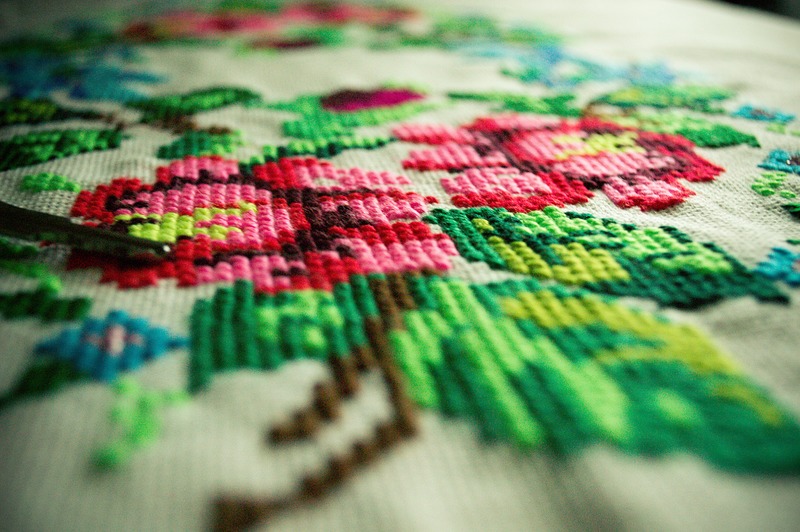Placing a name on the corner with a machine is one of the most popular ways on how to embroider a blanket.

What better way to personalize your gift for your loved ones?
It is a simple design, but it adds great sentimental value to your piece. You need to use a machine to get the best results for your craft.
Here is all you need to know about these beautiful decorations.
What Is Embroidery?
Embroidery is when you put a design on a piece of clothing, and these can range from your initials to mini flowers and birds.
People initially did it using a needle, and it was a symbol of wealth in Europe.
The design can be a stitch on top of your fabric or thread used to make a pattern.
It’s easy enough for beginners to follow, and with the dawn of technology, the process has become simpler.
What Materials Do You Need For Embroidery?
New technological advances make the embroidery process simpler. There are still some traditional materials you need, though, such as the thread.
These are what you will need:
- Your good quality blanket
- An embroidery hoop
- Embroidery thread of any color, Polyester is an excellent choice
- Your embroidery needle, a 75/11 machine needle, is just right
- A washable marking pen to mark the area
- Scissors and Pins to stabilize the material
- Your sketched design
For the equipment, you must have:
- An embroidery machine
- Tear-away or cut-away stabilizer to keep your blanket in place during stitching
- A water-soluble topping to make the stitches look invisible
- Fabric adhesive
Once you have everything ready, you can start the embroidery process.
Step-By-Step Process On How To Embroider A Blanket
You may find all the special equipment intimidating, but once you get the hang of the process, you won’t be able to stop using your machine!
It will save you so much time compared to embroidery by hand.
Step#1. Prep your blanket
Make sure your throw is already washed and dried so there won’t be any surprise shrinking!
Step#2. Mark where your embroidery will go
Use your water-soluble marker to do this. A simple “x” is good enough; just remember to give a little allowance with the measurement.
Step#3. Hoop or float your blanket
You can choose either of these two procedures based on the thickness of your blanket.
Hooping is best for a thin blanket.
You need to place a stabilizer at the back and topping at the front, then use your embroidery hoop to align them until your “x” mark is at the center.
Floating is a better choice for thick blankets. You need to hoop the stabilizer first, then apply the temporary adhesive spray to secure the blanket onto it.
Step #4. Set up your machine
Upload your design to the machine, or choose an already-existing font. It’s best to place it at a 90-degree angle so your extra blanket won’t be spread about.
Attach the hoop and start your machine, then use the touchscreen to align the design.
Monitor that everything is going well for a few minutes, then you can leave it alone.
Step#5. Clean up the design
Once your design is finished, remove the hoop, then take out the stabilizer and topping. If there are any jump stitches, you may trim them.
Now enjoy the beautiful, personalized blanket you made!
What Is The Best Type Of Blanket To Embroider?
You must be thinking, you know all about how to embroider, but what type of fabric can you embroider on?
Well, luckily, any kind of material will do as long as it’s not too thick like wool.
Some standard fabrics used for embroidery are Linen, Cotton, Silk, Satin, and even Canvas. They are easy to handle and put into the embroidery hoop.
Every material is unique, and it may have its own special properties; some may be more delicate than others.
That is why you should check them before your start embroidering to avoid mistakes or damage.
How To Care For Your Blanket
Now you have your beautiful blanket, how do you make sure it stays that way? You should wash your piece as sparingly as possible to preserve your work.
Test the thread if it can absorb the color of other fabrics; if it can, then have it washed at the dry cleaners.
If your piece looks dull but isn’t dirty, try to gently iron it to remove dust. Cover the nozzle with a nylon stocking to prevent damage.
If you need to, you may also hand-wash your piece with cold water. Use a mild detergent and oxygen-based bleach.
For drying, squeeze out the excess water gently, then let it dry flat on a towel.
Conclusion
Embroidery is a beautiful craft that can make unique pieces for your loved ones. It will bring life to any plain piece of cloth.
When you master how to embroider a blanket on a machine and take care of it, you will easily make crafts for your family.
So, what are you waiting for? Get your sketch ready and set up your machine!
